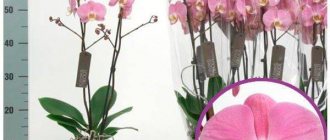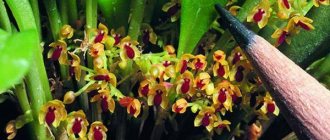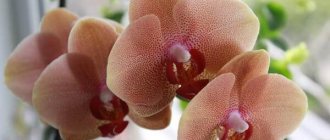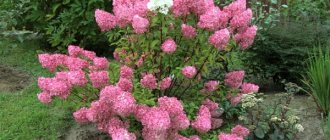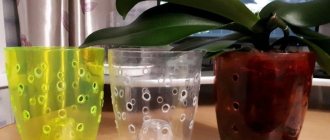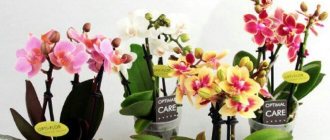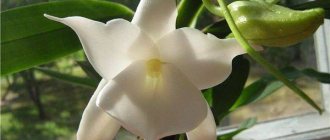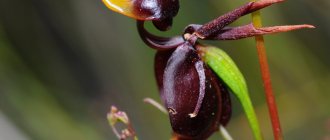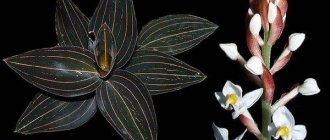Diamond King
Features and external characteristics
Phalaenopsis Diamond King is not a particularly rare variety, but is rarely found in flower shops. Usually having two or three gracefully inclined, straight, peduncles reaching 50 to 70 cm in height in adulthood. Quite a lot of buds are tied on each peduncle.
The leaf is quite large , fleshy, dense. The size of the leaf surface is up to 30 cm in length and 10 cm in width. The number varies from 3 to 5, depending on the care and conditions created.
Diamond King.
The flowers resemble bright burgundy butterflies , with a slightly lightened border. Closer to the center of the flower, leopard-print speckles resembling freckles look original.
Story
There is practically no information available in available sources about the origin of this hybrid. All that is known is that he is British . And perhaps, judging by the shape and appearance of the lower sepals, one of the parents was “Phalaenopsis stuartiana”.
Phalaenopsis stuartiana.
Colors
The main color is bright burgundy. Depending on conditions, soil, watering and fertilization, shades may change to light or dark. Often the flowers acquire a cherry color, with creamy tan marks.
The flower border is always lighter than the main color. And above the lip, in the center there are dark yellow spots.
Features, flowering duration and dormant period
It blooms for quite a long time, 3-4 months . Like all orchids of this type, 2 times a year.
With proper care and creation of normal, close to natural conditions, it can bloom 3 times.
Some gardeners cause artificial flowering , but frequent use of this method threatens to deplete the plant.
Flowering on the peduncle occurs almost simultaneously.
During this period, a new peduncle may appear, which can form buds and flowering will continue almost continuously.
The dormant period begins after flowering, before the formation of new buds or the appearance of a new peduncle to replace the one that has lost its vigor.
The video shows advice from an experienced gardener on how to replant the Daimon King orchid at home:
Little-known varieties of phalaenopsis: Diamond King, Dendrophalaenopsis, Wild Peach
In the modern flower market you can find almost any type of Phalaenopsis orchid. A variety of colors and sizes will satisfy any, even the most demanding taste .
And with the appearance of many hybrids , this flower became the most popular in home floriculture, winning the competition.
In this article we will consider the following varieties of phalaenopsis: Diamond King, Dendrophalaenopsis and Wild Peach.
Features and external characteristics
Phalaenopsis Diamond King is not a particularly rare variety, but is rarely found in flower shops. Usually having two or three gracefully inclined, straight, peduncles reaching 50 to 70 cm in height in adulthood. Quite a lot of buds are tied on each peduncle.
The leaf is quite large , fleshy, dense. The size of the leaf surface is up to 30 cm in length and 10 cm in width. The number varies from 3 to 5, depending on the care and conditions created.
Diamond King.
The flowers resemble bright burgundy butterflies , with a slightly lightened border. Closer to the center of the flower, leopard-print speckles resembling freckles look original.
Story
There is practically no information available in available sources about the origin of this hybrid. All that is known is that he is British . And perhaps, judging by the shape and appearance of the lower sepals, one of the parents was “Phalaenopsis stuartiana”.
Phalaenopsis stuartiana.
Colors
The main color is bright burgundy. Depending on conditions, soil, watering and fertilization, shades may change to light or dark. Often the flowers acquire a cherry color, with creamy tan marks.
The flower border is always lighter than the main color. And above the lip, in the center there are dark yellow spots.
Features, flowering duration and dormant period
It blooms for quite a long time, 3-4 months . Like all orchids of this type, 2 times a year.
With proper care and creation of normal, close to natural conditions, it can bloom 3 times.
Some gardeners cause artificial flowering , but frequent use of this method threatens to deplete the plant.
Flowering on the peduncle occurs almost simultaneously.
During this period, a new peduncle may appear, which can form buds and flowering will continue almost continuously.
The dormant period begins after flowering, before the formation of new buds or the appearance of a new peduncle to replace the one that has lost its vigor.
The video shows advice from an experienced gardener on how to replant the Daimon King orchid at home:
It is necessary to understand and know that Dendrophalaenopsis (Dendrobium phalaenopsis) or double-humped dendrobium is a natural species of orchid from the genus Dendrobium. Some gardeners also popularly call it “Dendrophal”.
Important! It has nothing to do with the hybrid between Dendrobium and Phalaenopsis or the species being crossed between it, since this is impossible to achieve, because they are not in a “closely related” relationship. This is an independent natural species.
But this species has its own hybrids. These are the ones we buy.
Dendrophalaenopsis.
Motherland
The homeland of this family of orchids and natural habitat is Australia, Singapore and New Guinea.
Features, flowering duration and dormant period
The color of the flowers of each hybrid can be completely different - ranging from pure white to very dark purple. The abundance of flowering depends on the amount and duration of daylight hours.
Unlike its species relatives, Dendrophalaenopsis does not have a dormant period during low temperatures. The plant is allowed to rest by reducing or reducing watering. Allow the substrate to dry and only then water it a little. In phalaenopsis this is normal maintenance and proper watering.
Varieties of Dendrophalaenopsis.
On average, flowering lasts about 2 months . But with 5-6 peduncles the bouquet looks amazing.
Why do dendrophalaenopsis leaves turn yellow?
The main conditions for the healthy development of a plant of this type of orchid are a sufficient amount of illumination and support for the plant, close to the seasonal climate changes that occur in its natural environment.
Yellowing of leaves can be due to several reasons:
- Increased room temperature;
- Ineffective use of complex fertilizing (overfeeding);
- Disruption of the root system.
The most common reason that new gardeners encounter is problems in the functioning of the root system due to overwatering or after transplantation.
especially careful about watering the plant. In nature, orchids grow on trees and in the open air after rain the roots dry out quite well. Therefore, prolonged exposure of roots to a humid environment leads to their ineffective work.
Watch a video about caring for dendrophalaenopsis at home:
Subspecies Dendrobium "Thailand Black"
This orchid is also called the “Black Orchid”, although they do not have a pure black color due to the fact that there are no pigment genes responsible for this color. This is one of the darkest species of Dendrophalaenopsis, having a dark burgundy or dark purple color.
Dendrobium Thailand Black
It has a high growth rate and relatively long flowering . In certain lighting it looks completely black.
Has an unusual flower shape . The petals are pointed and the leaves are narrow and long. It blooms frequently and quickly resumes flowering, which lasts from 2 to 3 months, depending on the conditions created and appropriate care. Peduncles can reach a length of 70 cm in an adult plant.
A distinctive feature of this phalaenopsis is the unusual coloring of the flowers . The shades of flowers largely depend on the conditions of maintenance and care.
Color can vary from orange to pink-orange. The inclusions are brick to burgundy with white dots. The lip of the flower is mostly dark crimson, and the column is bright lilac. See what the Wild Peach orchid looks like in the photo.
Phalaenopsis Wild Peach.
The flowers are quite large . Some plants reach 10.5 cm. The average size ranges from 8 to 9 cm. Peduncles, the number of which can reach 4 pieces, are quite strong and tall.
Destination (Phalaenopsis Destination)
There is no information available on this species. Perhaps Phalaenopsis Destination does not exist at all. If anyone has information on this species, please write it in the comments!
Any plant does not like transplantation and reacts negatively with its development for some time. The Dendrophalaenopsis orchid is even more critical of transplants.
It is important to choose a good soil (substrate), consisting of tree bark (preferably pine, but prepared) and other inert components, selected in the correct proportion.
You should also observe:
- The arrival of light
- air circulation,
- Drainage in a flower pot.
Conditions of detention
Caring for modern types of orchids is not very difficult. The main thing is to follow the rules:
- Temperature regime . It is enough to adhere to daytime temperatures of 22-24° C and night temperatures of 15-18° C. Such a difference between temperatures has a beneficial effect on the development and flowering of the orchid;
- Humidity . Air humidity of 40-60% is considered normal. With low or high humidity, growth slows down, flowers begin to dry out, buds fall off, or the color of the foliage changes;
- Lighting. Direct sunlight is strictly prohibited. The plant should be in a well-lit place, but without direct sunlight. Daylight hours should be at least 10 hours.
These conditions are quite easy to establish at home, using in exceptional cases an air humidifier, ventilation or a phytolamp.
Watering and fertilizing
The frequency of watering directly depends on:
- Temperatures
- Lighting,
- Humidity.
The higher the temperature and sufficient lighting, the more often watering is done. The water should be soft and warm (32-34°). It is better to use distilled or rain water.
During the cold season, watering is noticeably reduced.
Proper watering of an orchid.
During the hot period, watering depends on the ability of the root system to absorb and dry the roots. Typically, watering is done once every three days.
Additional nutrition is added during the period of active growth at every third watering. For this purpose, special fertilizers for orchids are used.
Advice! It is better to reduce the proportion recommended by the manufacturer by 2 times. It is better to underfeed than to overfeed an orchid.
Disease Prevention
Basic preventive measures are carried out after purchasing a new pet:
- The substrate changes
- Suspicious areas are treated with fungicidal preparations.
During the growing period, important prevention is compliance with the growing conditions and compliance with the rules of care.
The nuances of transplantation
Any plant has a negative attitude towards transplantation. Acclimatization to new conditions is quite painful and takes a long time.
Therefore, transplantation should be carried out only as a last resort :
- After the purchase,
- If the landing container is cramped,
- For diseases of the root system.
Watch the video for a review of phalaenopsis orchid species:
Video review of the Dendrophalaenopsis species:
Watch the video description of Phalaenopsis Wild Peach:
Dendrophalaenopsis
It is necessary to understand and know that Dendrophalaenopsis (Dendrobium phalaenopsis) or double-humped dendrobium is a natural species of orchid from the genus Dendrobium. Some gardeners also popularly call it “Dendrophal”.
Important! It has nothing to do with the hybrid between Dendrobium and Phalaenopsis or the species being crossed between it, since this is impossible to achieve, because they are not in a “closely related” relationship. This is an independent natural species.
But this species has its own hybrids. These are the ones we buy.
Dendrophalaenopsis.
Motherland
The homeland of this family of orchids and natural habitat is Australia, Singapore and New Guinea.
Features and external characteristics
Externally, Dendrophalaenopsis looks like Dendrobium. It has tall, thick bulbs with numerous growing points. But flowering occurs on peduncles, like phalaenopsis.
This perennial orchid has a sympodial growth habit. It has many thick, fleshy-looking shoots - pseudobulbs, which grow on the rhizome (rhizome).
The plant grows quite quickly . With enough light, new shoots can grow throughout the year.
Peduncles are quite long. They grow from the upper nodes. The number of flowers on each peduncle is impressive Depending on the hybrid, flower sizes range from 4 to 8 cm.
Features, flowering duration and dormant period
The color of the flowers of each hybrid can be completely different - ranging from pure white to very dark purple. The abundance of flowering depends on the amount and duration of daylight hours.
Unlike its species relatives, Dendrophalaenopsis does not have a dormant period during low temperatures. The plant is allowed to rest by reducing or reducing watering. Allow the substrate to dry and only then water it a little. In phalaenopsis this is normal maintenance and proper watering.
Varieties of Dendrophalaenopsis.
On average, flowering lasts about 2 months . But with 5-6 peduncles the bouquet looks amazing.
Why do dendrophalaenopsis leaves turn yellow?
The main conditions for the healthy development of a plant of this type of orchid are a sufficient amount of illumination and support for the plant, close to the seasonal climate changes that occur in its natural environment.
Yellowing of leaves can be due to several reasons:
- Increased room temperature;
- Ineffective use of complex fertilizing (overfeeding);
- Disruption of the root system.
The most common reason that new gardeners encounter is problems in the functioning of the root system due to overwatering or after transplantation.
especially careful about watering the plant. In nature, orchids grow on trees and in the open air after rain the roots dry out quite well. Therefore, prolonged exposure of roots to a humid environment leads to their ineffective work.
Watch a video about caring for dendrophalaenopsis at home:
Subspecies Dendrobium "Thailand Black"
This orchid is also called the “Black Orchid”, although they do not have a pure black color due to the fact that there are no pigment genes responsible for this color. This is one of the darkest species of Dendrophalaenopsis, having a dark burgundy or dark purple color.
Dendrobium Thailand Black
It has a high growth rate and relatively long flowering . In certain lighting it looks completely black.
Has an unusual flower shape . The petals are pointed and the leaves are narrow and long. It blooms frequently and quickly resumes flowering, which lasts from 2 to 3 months, depending on the conditions created and appropriate care. Peduncles can reach a length of 70 cm in an adult plant.
Main types of orchids and options for caring for them: watering, fertilizing and others
There is a huge variety of species and varieties of orchids that are bred artificially. In order for the plant to delight with beautiful flowers and not require resuscitation, it is necessary to water it correctly, feed the soil, and set the correct temperature. In general, caring for an orchid consists of providing basic conditions for indoor flowers.
Description of the orchid
The bush version is extremely rare; stem and vine-like varieties are offered on the market. Everyone is accustomed to the fact that an orchid is an indoor flower that has a unique structure of leaves and stem and blooms beautifully, throwing out a long arrow. In nature, the plant is a sticky plant that is located on tree trunks.
Blooming orchid
There are two groups of orchids - epiphytes and lithophytes. A distinctive feature is the presence of underground tubers or roots, which perform many functions, ensuring the normal functioning of the plant.
Reproduction is carried out by planting children, which can form on the peduncle, at the root, or on the stem.
For your information! In place of the flowers, boxes appear containing several million seeds.
Scientific name
When buying a beautiful pot with an indoor flower, not many people think about whether it is correct: archid or orchid, what is the scientific name of the flower. If you examine the literature on botany, you can find a plant name that is completely unknown to the general public - phalaenopsis.
Sometimes there is a common name that sounds completely new even to experienced gardeners, namely dendrobium. This variant of the name defines the Orchidaceae family, which belongs to the genus of herbaceous plants.
Appearance of an orchid
What does an orchid look like?
Many people are confident that they know and can accurately describe what an orchid looks like. But in fact, there are several variations of this plant, which at first glance completely contradict the appearance presented in pots on the window sills of gardeners.
External data of one of the varieties
Distinctive features of the appearance of the flower:
- the length and shape of the stem can be different - short, long, straight, vine-shaped;
- leaves may have an oval or slightly elongated shape. They are dense, fleshy, emerald or green in color;
- Orchid flowers have a complex structure. The bud consists of several petals of non-standard shape. In addition, the color can be very diverse;
- flowering can occur in a spike, singly or in a brush with several buds arranged along the peduncle;
- the root system is no less impressive. The shoots are thick, usually green or gray-green in color. They resemble crooked tubes.
An orchid flower looks aesthetically attractive on a windowsill, especially during the flowering period. Thanks to the unique combination of diverse flowers and leaves, it is difficult to even imagine what types of orchids there are.
Main types of orchids
Cymbidium orchid: options for growing and caring at home
There are completely different types of orchids in external characteristics, which belong to different families. Each species has several varieties. When choosing a plant, you should carefully study the characteristics of the specimen so as not to buy a harmful indoor flower.
Varieties and types of orchids
Note! The most detailed classification was proposed by R. L. Dressler; he suggested that it would be more convenient to divide orchids into five subfamilies.
Varieties of orchids differ from each other in the shape and size of the flower, the type of flowering, and the appearance of the trunk itself. The choice can be made according to even visual preference.
The most popular flower varieties:
Hysis orchid
The hysis species are plants that have bright green leaves with a sharp tip. Flowering lasts about six months - from April to October. During this period, a peduncle grows, on which there are about seven buds.
The color scheme is as close as possible to yellow and orange. Purple buds are less common. The petals are decorated with spots and stripes of dark color.
Orchid Monza
Growing the Monza variety is a pleasure. The flower is large and can reach a diameter of more than 10 cm; the edges of the petals are slightly darker than the bud itself. The bud itself has a muted coral color. The leaves are dark green, oval shaped, with a dense texture.
What does a Monza orchid look like?
Diamond King
The most popular variety is Diamond King, which is a dark and bright burgundy butterfly. Sometimes it has a bud with a black rim or dark core. The leaves are dense and large emerald green.
Orchid Andorra
The name of this beautiful variety matches the appearance of the bud. Many flowers are formed on the peduncle, which bloom one after another. The shape of the flower is close to the appearance of a large butterfly. The petals are purple or lilac. And along them are specks or stripes of a darker color.
Orchid Jewel
Jewel buds of dark purple or lilac color are located along the peduncle. Flowering continues for more than six months. The castings are dense and have a rich dark green color. Medium sized buds.
Variety Jewel
Varieties of orchids are so common in breeding that it is almost impossible to determine which one became the basis. Different types of buds that resemble butterflies, hummingbirds, and insects can be combined with diverse leaves.
For your information! There are about 150 varieties of selectively bred orchids.
Home care options
Fertilizer for orchids: examples of feeding at home
Inexperienced gardeners often wonder how to grow an orchid at home. It is important to create the right conditions for the growth and development of the flower.
Important! Care should be carried out in accordance with the recommendations that come with the plant variety.
There are several basic nuances that relate to temperature, watering, lighting, soil and fertilizers.
Temperature
Growing healthy and full-fledged specimens is possible only in artificial tropical conditions. At home, you can also set this temperature regime. The secret is to fully moisturize the place where the orchid grows. You can put a glass of water next to it.
Note! At rest, that is, in winter, the normal temperature will be between 15 °C and 18 °C. The temperature should not change within seven degrees.
Lighting
The plant does not tolerate direct sunlight, as burns may remain on the leaves. As a result, the stem and other parts begin to wither and then dry out completely. It is advisable to place the flowerpot in partial shade or on a windowsill that faces southwest.
Illumination level
In the cold season, light and heat may, on the contrary, be insufficient, so special fluorescent lamps can be used as an artificial source.
Soil and fertilizing
When replanting, you need to choose the right soil. Usually it is a mixture of finely chopped dry bark with pieces of moss. The components are taken in equal proportions. Additionally, a drainage layer is selected for the bottom of the flowerpot.
Appearance of soil for an orchid
The correct feeding regime is also important for the normal growth and flowering of the orchid. You can use organic and inorganic fertilizers. You can fertilize once a month, but the dose should be several times less than the standard one.
Regularity of watering
The root of the plant is very sensitive to moisture. The important thing here is not to overfill it and not let it dry out. Be sure to choose the right pot with transparent walls and holes to remove excess liquid.
The principle of proper watering
Important! The flowerpot should be placed in a bowl of water for 10 minutes, and then the excess moisture should be allowed to drain. It is not recommended to pour water into the pot onto the roots.
Watering is carried out in accordance with the needs of the flower, since the drying of the substrate depends on several external fluorines of the location of the flowerpot. Typically, watering is done once every 1-2 weeks.
Orchid blossom
Phalaenopsis propagation at home: examples by children and cuttings
The orchid has a whimsical nature regarding flowering. Many specimens never bloom. There are several ways to make an orchid bloom. You need to create a stressful situation for the plant:
- make sudden changes in temperature;
- stop watering for a week, and then place in warm water;
- increase the dose of fertilizers at the time of feeding.
Features of orchid flowering
But the conditions of care at the time of flowering and after it differ.
Care during flowering
If you properly care for a flowering plant, this period will last a long time. It is necessary to water the flower on time, remove dried and limp buds. You need to feed the plant at least once every 2 weeks.
Caring for an orchid at home after flowering
After flowering, you need to transfer the flower to the dormant stage, and also:
- remove the peduncle by cutting it with a sharp pruner;
- leaves that have withered or dried out must also be removed;
- It is advisable to stop frequent watering and reduce the amount of fertilizing.
For flowering to stop and resume the following year, the plant must rest well during the winter.
You can decorate your home with a blooming orchid of the selected variety if you properly care for the flower. You should first study all the features of the species and choose a suitable place for it in the house.
Source: https://pocvetam.ru/komnatnye-rasteniya/orhidei/uhod.html
Wild peach (Phalaenopsis "Wild Peach")
Distinctive features and external characteristics
A distinctive feature of this phalaenopsis is the unusual coloring of the flowers . The shades of flowers largely depend on the conditions of maintenance and care.
Color can vary from orange to pink-orange. The inclusions are brick to burgundy with white dots. The lip of the flower is mostly dark crimson, and the column is bright lilac. See what the Wild Peach orchid looks like in the photo.
Phalaenopsis Wild Peach.
The flowers are quite large . Some plants reach 10.5 cm. The average size ranges from 8 to 9 cm. Peduncles, the number of which can reach 4 pieces, are quite strong and tall.
Story
The history of hybrid phalaenopsis is quite difficult to trace . Hybridization is a fairly long process, starting from natural ones and ending with the hybridization of a number of phalaenopsis with different colors and sizes of flowers, etc.
Surely it could not have happened without Phalaenopsis stuartianum, which became the progenitor of inclusions, spotting and patterns on the petals. Spotted phalaenopsis wild peach, photo below.
Features of flowering, flowering duration and dormant period at home
No peculiarities were noticed in the flowering:
- The duration can also be from 2 to 4 months;
- The rest period cannot be clearly defined by date or season;
- After flowering, the plant needs to grow leaves and root parts;
- Under normal conditions and the necessary temperature changes, phalaenopsis blooms again quite quickly.
Important! If the plant is dormant for a long time, then it is simply tired and needs to gain strength.
And in this video you can look at Wild Peach in more detail:
General information on orchids: planting features
Any plant does not like transplantation and reacts negatively with its development for some time. The Dendrophalaenopsis orchid is even more critical of transplants.
It is important to choose a good soil (substrate), consisting of tree bark (preferably pine, but prepared) and other inert components, selected in the correct proportion.
You should also observe:
- The arrival of light
- air circulation,
- Drainage in a flower pot.
Home care rules
Conditions of detention
Caring for modern types of orchids is not very difficult. The main thing is to follow the rules:
- Temperature regime . It is enough to adhere to daytime temperatures of 22-24° C and night temperatures of 15-18° C. Such a difference between temperatures has a beneficial effect on the development and flowering of the orchid;
- Humidity . Air humidity of 40-60% is considered normal. With low or high humidity, growth slows down, flowers begin to dry out, buds fall off, or the color of the foliage changes;
- Lighting. Direct sunlight is strictly prohibited. The plant should be in a well-lit place, but without direct sunlight. Daylight hours should be at least 10 hours.
These conditions are quite easy to establish at home, using in exceptional cases an air humidifier, ventilation or a phytolamp.
Watering and fertilizing
The frequency of watering directly depends on:
- Temperatures
- Lighting,
- Humidity.
The higher the temperature and sufficient lighting, the more often watering is done. The water should be soft and warm (32-34°). It is better to use distilled or rain water.
During the cold season, watering is noticeably reduced.
Proper watering of an orchid.
During the hot period, watering depends on the ability of the root system to absorb and dry the roots. Typically, watering is done once every three days.
Additional nutrition is added during the period of active growth at every third watering. For this purpose, special fertilizers for orchids are used.
Advice! It is better to reduce the proportion recommended by the manufacturer by 2 times. It is better to underfeed than to overfeed an orchid.
Disease Prevention
Basic preventive measures are carried out after purchasing a new pet:
- The substrate changes
- Suspicious areas are treated with fungicidal preparations.
During the growing period, important prevention is compliance with the growing conditions and compliance with the rules of care.
The nuances of transplantation
Any plant has a negative attitude towards transplantation. Acclimatization to new conditions is quite painful and takes a long time.
Therefore, transplantation should be carried out only as a last resort :
- After the purchase,
- If the landing container is cramped,
- For diseases of the root system.
Orchid blossom
How to plant an orchid: examples in a pot and at home
The orchid has a whimsical nature regarding flowering. Many specimens never bloom. There are several ways to make an orchid bloom. You need to create a stressful situation for the plant:
- make sudden changes in temperature;
- stop watering for a week, and then place in warm water;
- increase the dose of fertilizers at the time of feeding.
Features of orchid flowering
But the conditions of care at the time of flowering and after it differ.
Care during flowering
If you properly care for a flowering plant, this period will last a long time. It is necessary to water the flower on time, remove dried and limp buds. You need to feed the plant at least once every 2 weeks.
Caring for an orchid at home after flowering
After flowering, you need to transfer the flower to the dormant stage, and also:
- remove the peduncle by cutting it with a sharp pruner;
- leaves that have withered or dried out must also be removed;
- It is advisable to stop frequent watering and reduce the amount of fertilizing.
For flowering to stop and resume the following year, the plant must rest well during the winter.
You can decorate your home with a blooming orchid of the selected variety if you properly care for the flower. You should first study all the features of the species and choose a suitable place for it in the house.
